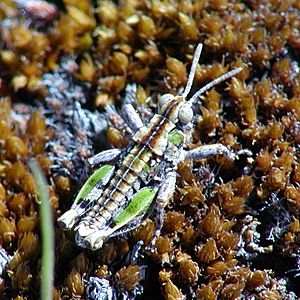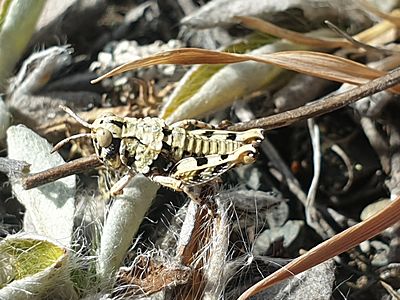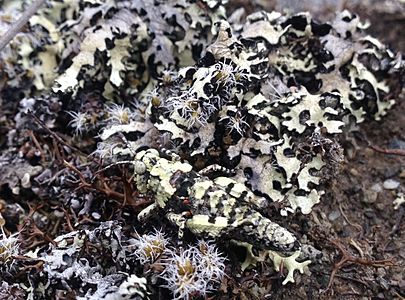Sigaus minutus facts for kids
Quick facts for kids Sigaus minutus |
|
|---|---|
 |
|
| Conservation status | |
|
Invalid status (NZ TCS)
|
|
| Scientific classification | |
| Genus: |
Sigaus
|
| Species: |
minutus
|
Sigaus minutus is a species of short-horned grasshopper in the family Acrididae. It is one of the smallest and rarest species of grasshopper in New Zealand, found only in the Mackenzie district of South Island. There are nine species within the genus Sigaus described by Bigelow (1967), all endemic to New Zealand. The population status of Sigaus minutus is declining according to threat assessments made by orthopteran experts in 2010.
Contents
Habitat and distribution
Sigaus minutus is found near Lake Tekapo, Lindis Pass and in the Mackenzie district, South Island, New Zealand. This grasshopper is very well camouflaged on stony surfaces and amongst lichen. It is absent in areas of dense vegetation as it needs to bask.
Morphological characters
Sigaus minutus is one of the smallest Sigaus species but very similar to the Otago species S. childi. Genetically, S. minutus is sister to the alpine species S. campestris from central and southern South Island mountains. As seen in most New Zealand grasshoppers, these species are all without functioning wings and their cryptic colouring is variable within populations but always aids camouflage. Females are larger than males.
Dimensions
Adult male: length 9–10 mm, pronotum length 1.6-1.9 mm, pronotum width 1.80-2.20 mm, femur length 4.90-5.60 mm, femur width 1.60-1.90 mm.
Adult female: length 14 –16 mm, pronotum length 2.50-2.65 mm, pronotum width 3.05- 3.30 mm, femur length 7.00-7.20 mm, femur width 2.10-2.50 mm.
- Cryptic colour variation in ''Sigaus minutus''
Behavior
As with other New Zealand grasshoppers, S. minutus is a diurnal herbivore, requiring open ground to bask. Males are smaller than females when adult and will remain on the back on the females (in copula) during prolonged mating. Eggs are laid in the soil.
Areas for conservation
The majority of populations of S. minutus are on small isolated patches of privately owned farmland where land management practices will ensure their extinction. In a survey of 20 sites on Crawford Hills Rd, Alexandra (Jamieson & Manly 1997), no Sigaus childi or S. minutus were found on land which is in pasture, used for growing orchards, or being irrigated. Experiments have shown that acridids cannot tolerate insecticides or herbicides and are very sensitive to heavy metals and fertilizers in the soil.




